
ALL YOU NEED TO KNOW - 2025 HUNGARIAN GRAND PRIX
Table of Contents
Circuit Characteristics and Challenges, Key Corners, Racing Considerations, Overtaking Opportunities, Braking Demands, Weather Outlook, Historical Records and Statistics and more...
The Hungarian Grand Prix, a consistent presence on the Formula 1 calendar since its 1986 debut, holds a distinct place in the sport's history. It marked the first Formula 1 event held behind the "Iron Curtain" during the Cold War, causing quite a stir. As it approaches its 40th running, the Hungaroring continues to present a unique challenge, often described as a tight, technical circuit demanding precision and strategic acumen.
Circuit Characteristics and Challenges
The 4.381-kilometer Hungaroring is a winding circuit, featuring 14 corners, six left and eight right. Many of these corners follow in quick succession, making a well-balanced car that can handle rapid directional changes vital for a competitive lap time. The layout includes various corner types, from those requiring heavy braking to low-speed turns. Turn 5, for example, is taken blind, with the contours creating a heightened sense of speed.
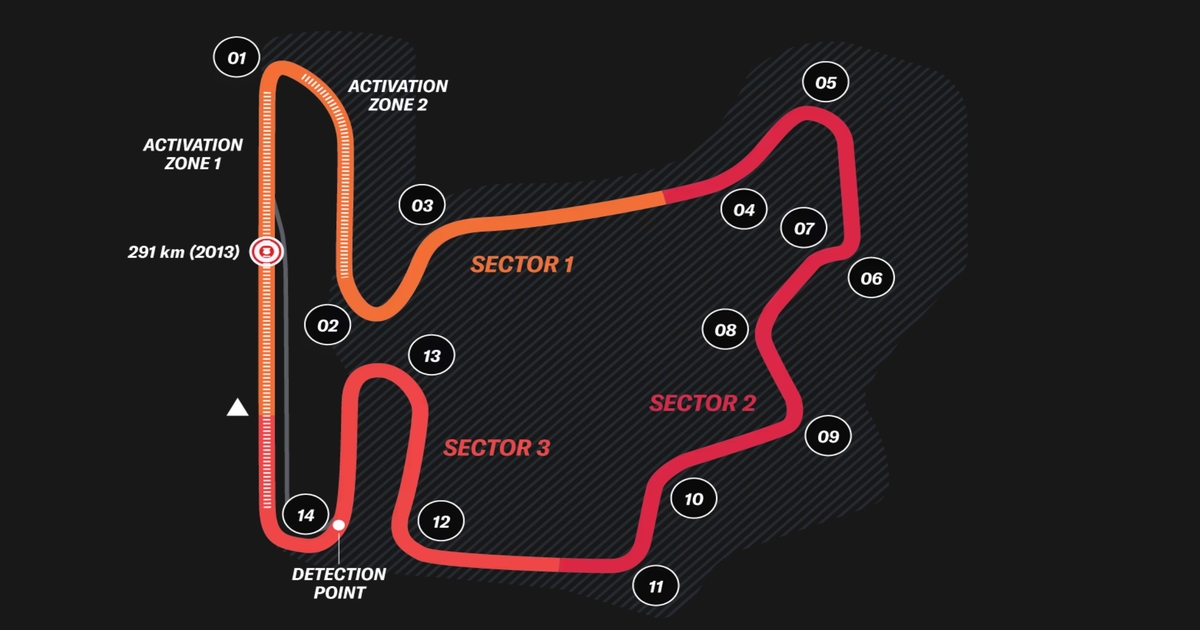
The circuit has one of the season's lowest top speeds, typically just over 315 km/h. Cars spend a mere 10 seconds on a straight during a fast lap, with the majority of the time spent cornering. This is reflected in the full-throttle percentage, which stands at approximately 53% of the lap time and 60% of the lap distance, some of the lowest figures seen all year. This configuration places a premium on high aerodynamic load and mechanical grip.
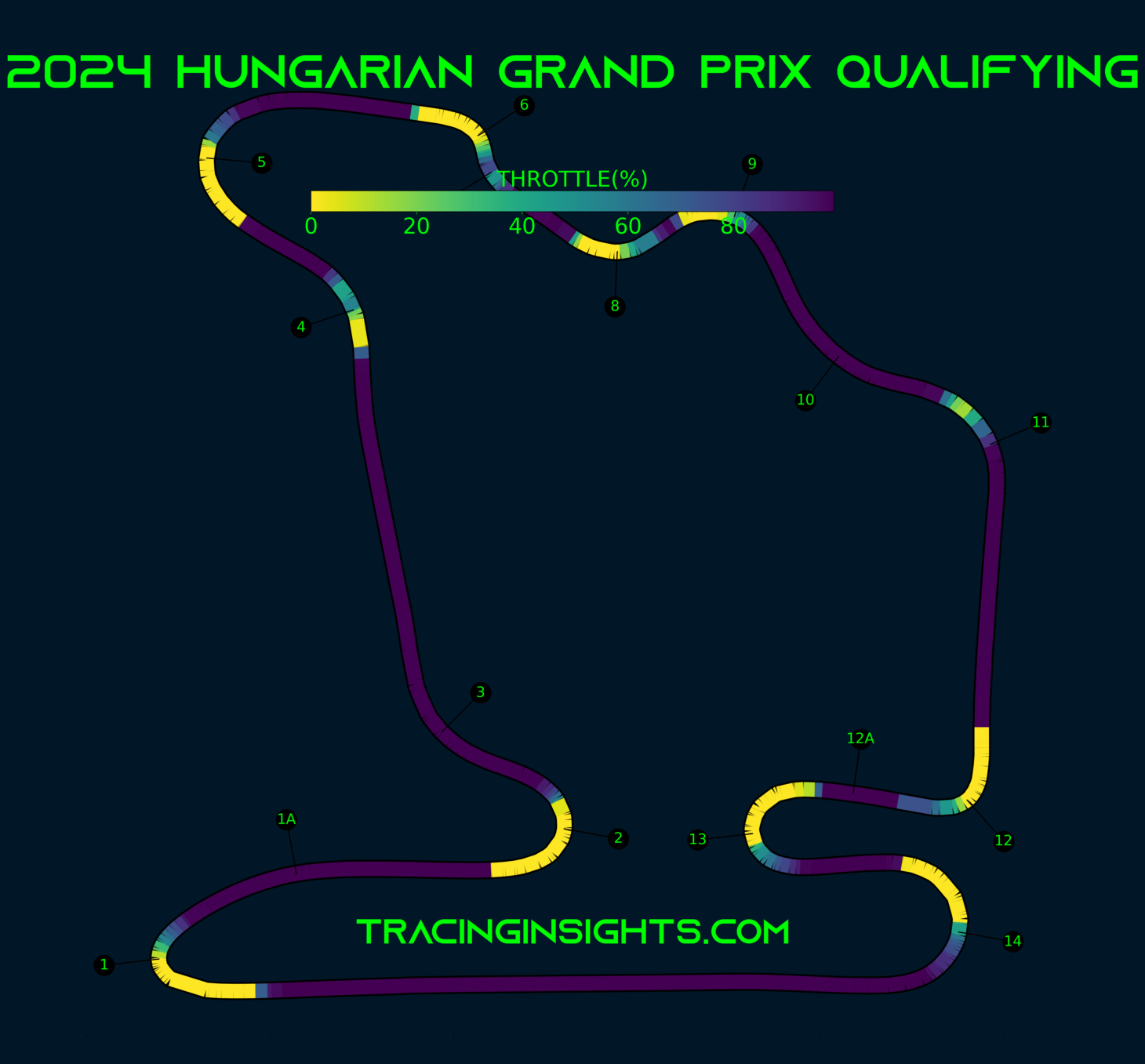
The Hungaroring, rarely used outside of major race weekends, is typically dusty, dirty, and offers minimal grip. This low initial adhesion sets the stage for substantial track evolution, where grip levels and lap times improve throughout the weekend. The ongoing construction work and a newly resurfaced main grid suggest this year's evolution will be even more pronounced. This rapid change in surface quality holds much weight for single lap performance. Optimal track timing becomes a critical factor in qualifying, as being on circuit at the precise moment can separate a strong grid position from a difficult Sunday race through the field. While the Hungaroring's surface has seen improvements in recent years, moving past its previously bumpy characteristics, initial Friday running still contends with reduced grip. This grip then gradually builds as tire rubber is laid down, a process especially noticeable during the first two days. The circuit's tight and technical layout genuinely allows a Formula 1 car to show its best during qualifying.
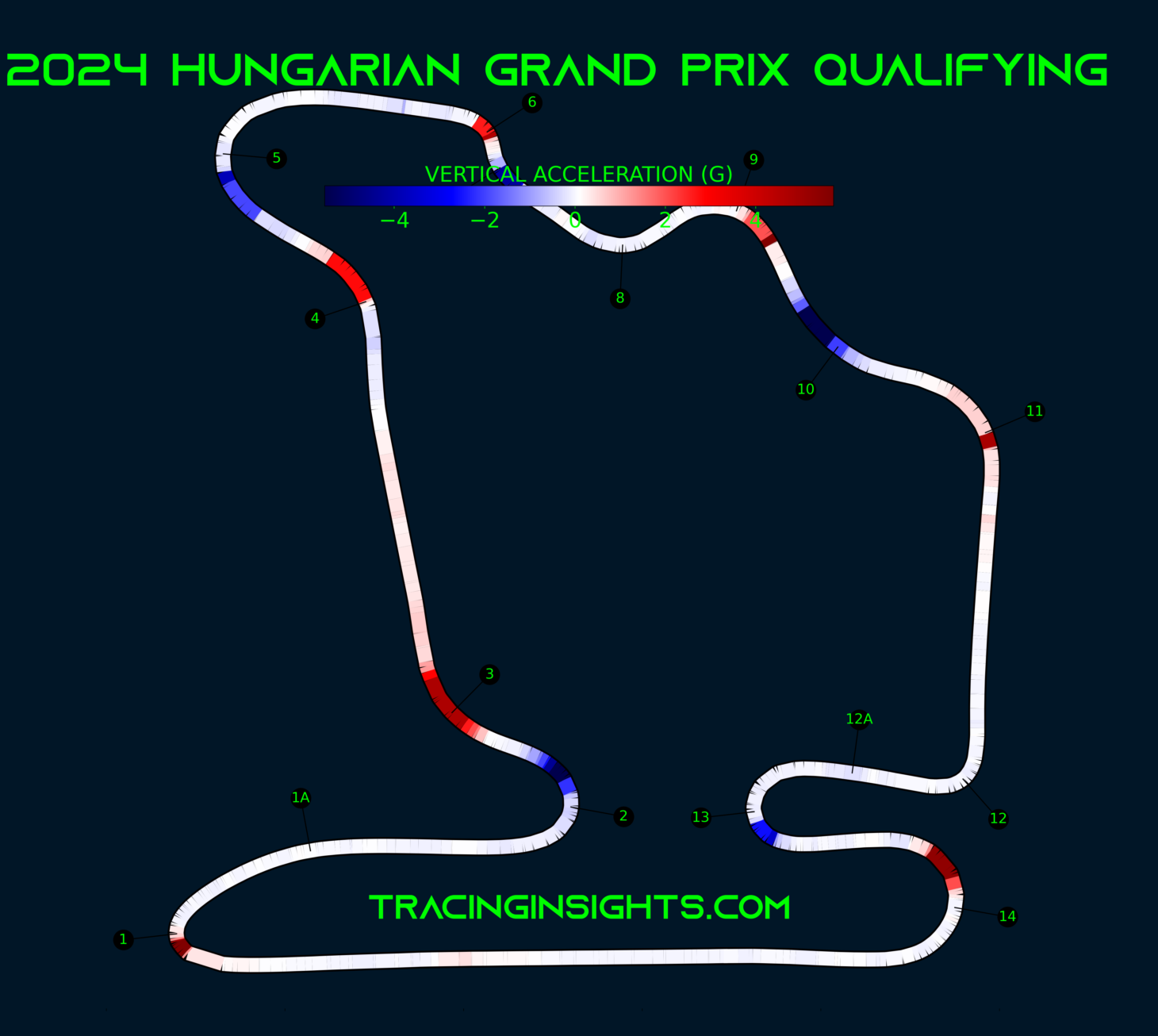
The intense heat often experienced during the Hungarian Grand Prix weekend, with air temperatures reaching up to 33°C and track temperatures averaging 36°C and rising to over 50°C, makes the race a physical test for drivers. This heat also contributes to the predominantly thermal degradation of tyres, a factor worsened by the very dark track surface.
Pit Lane and Technical Features
The Hungaroring facility is currently undergoing a significant transformation. The paddock area has been refurbished, and this year's main changes involve the pit lane, the main straight, the pit complex, and the main grandstand. The grid area and pit lane have been resurfaced using 860 tonnes of a specially designed mix, featuring bitumen with a higher softening point. This asphalt was laid to minimize undulations, aiming for a more consistent surface. The new surface has already seen use during GT races in early July, and its grip levels will be analyzed in the coming days.
The pit stop time loss at the Hungaroring is approximately 20.6 seconds.
Key Corners
The circuit's layout features several notable corners. Turn 5 is particularly exciting, taken blind, with its contours enhancing the sensation of speed. Turn 3, a left-hand downhill turn following a good exit from Turn 2, allows for different interpretations regarding the optimal racing line.
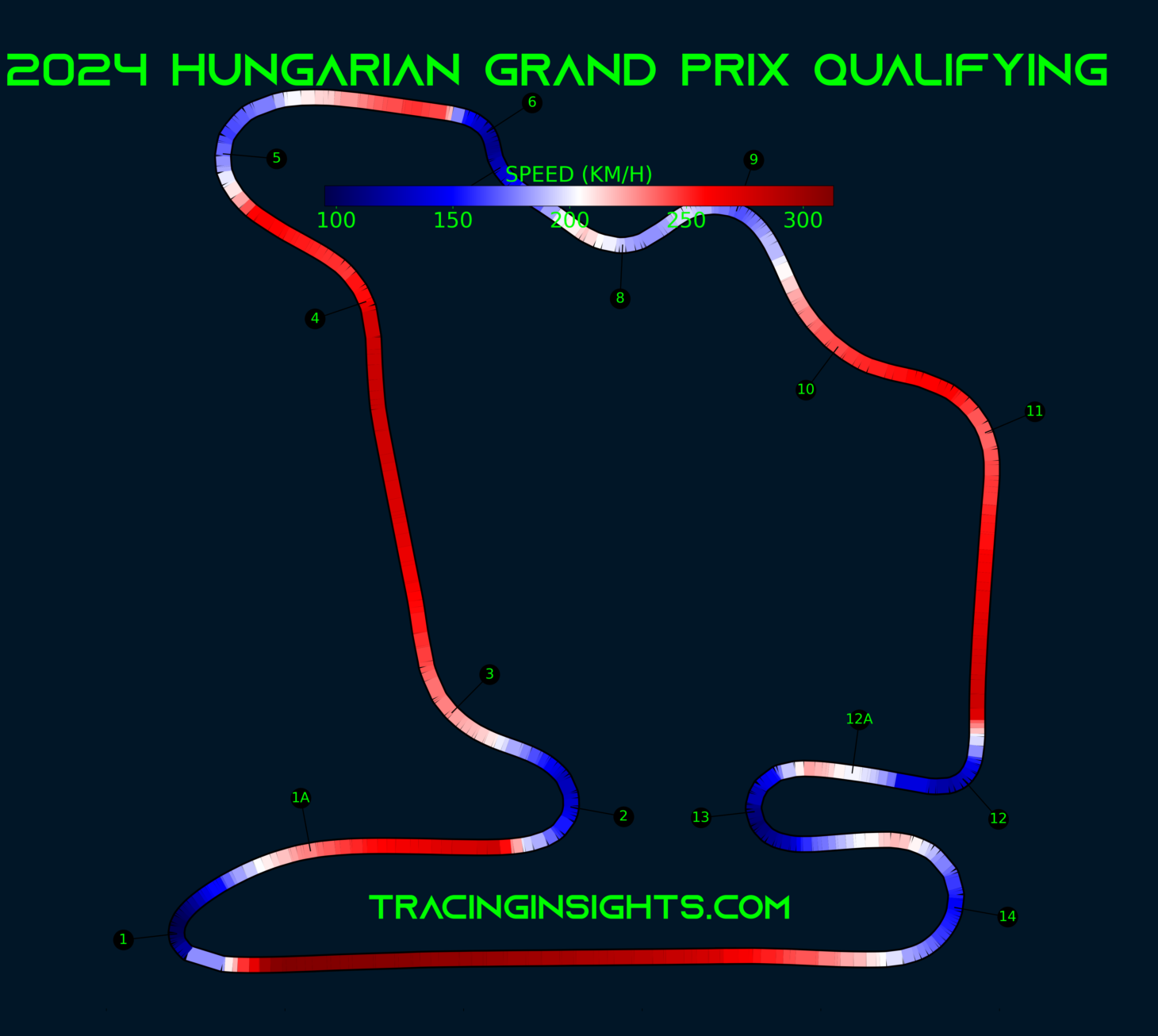
Racing Considerations
The Hungaroring, often likened to "Monaco without walls" due to its narrow, short, and slow nature, has traditionally been a circuit drivers enjoyed more on a Saturday than a Sunday. Its flowing corner combinations provide a strong challenge against the clock but historically frustrated drivers in the race due to limited overtaking opportunities. However, the circuit's character has seen a shift in recent years.
Qualifying holds considerable importance here. The distance from pole position to the braking zone for Turn 1 measures 472 meters, the fourth-longest run of the season, offering a significant drag race at the start. The final few grid slots even curve around the corner, necessitating a second set of start lights.
The circuit's tight and technical nature means mistakes are often punished. Power and straight-line speed are less critical than a driver's ability to find the limit and brake late. The constant interaction between aerodynamic and mechanical grip means there is little respite for the tyres or the driver, with finding a consistent rhythm, particularly in the second sector, being a key to performance.
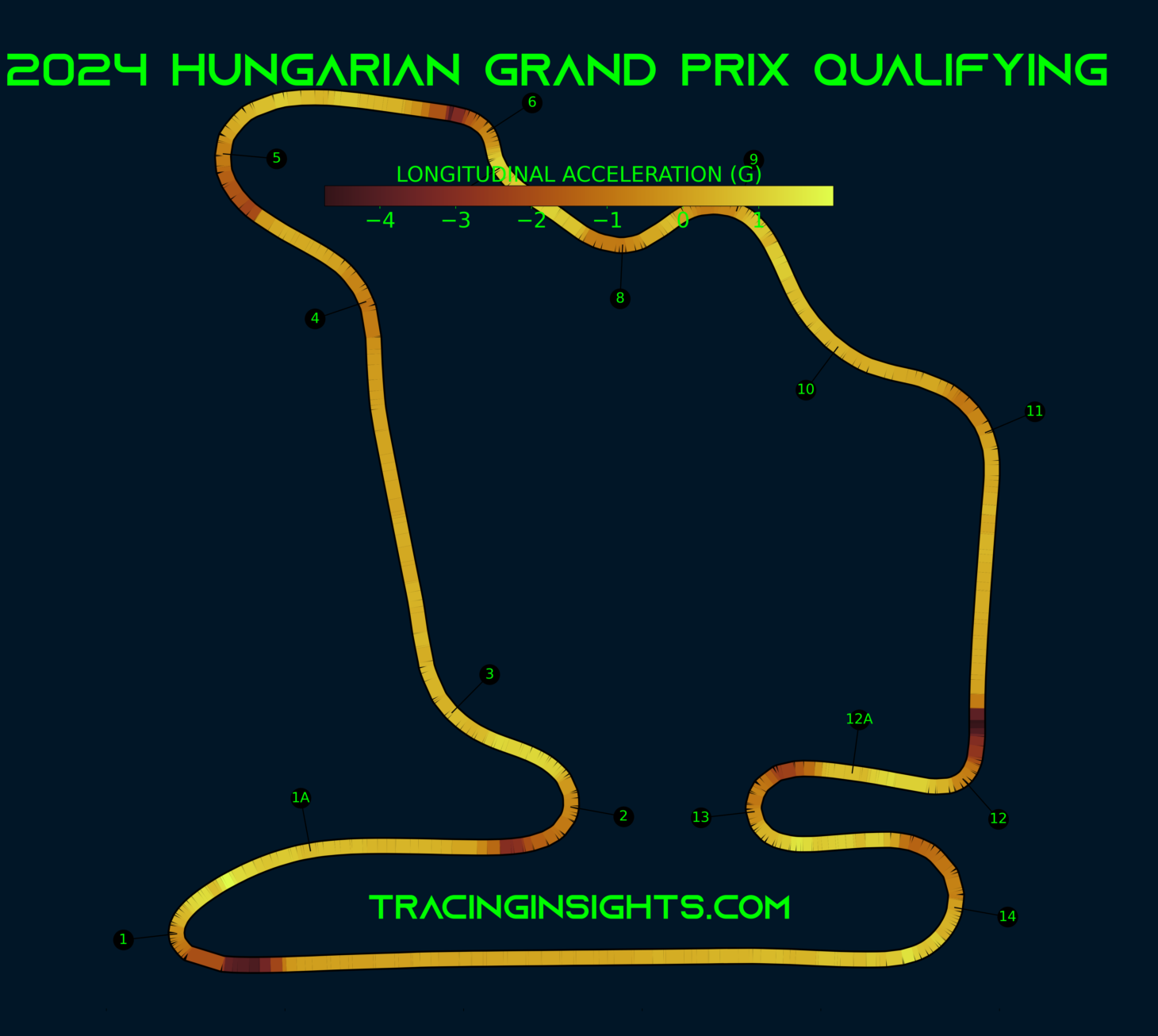
From a spectator standpoint, the track is set in a natural amphitheater, with most grandstands and the fan village wrapping around the final corner, main straight, and first corner. The natural contours also provide ample general admission space on the hillside, creating a wall of noise audible in the pit lane. The proximity to Budapest and its mid-summer calendar slot make it a popular destination for tourists.
Overtaking Opportunities
Historically, overtaking at the Hungaroring was a rare occurrence, with the circuit often described as "overtaking all but impossible." However, its reputation for processional races has changed. The ground-effect cars and track resurfacing have improved the ability to follow closely through corners, particularly the long final corner leading onto the main straight.
The primary overtaking point is Turn 1, a heavy braking zone aided by DRS. If a driver does not complete a move there, they can often capitalize on a defender going too deep, getting offline, and becoming vulnerable into Turn 2. A shorter DRS zone also exists towards Turn 2, sharing the same detection point. Turn 12 also presents a rare but possible overtaking chance, especially with a tyre offset. Turns 10 to 12 are worth watching for wheel-to-wheel action, as cars can be taken quickly ahead of two slower corners, bunching them up before the main straight.
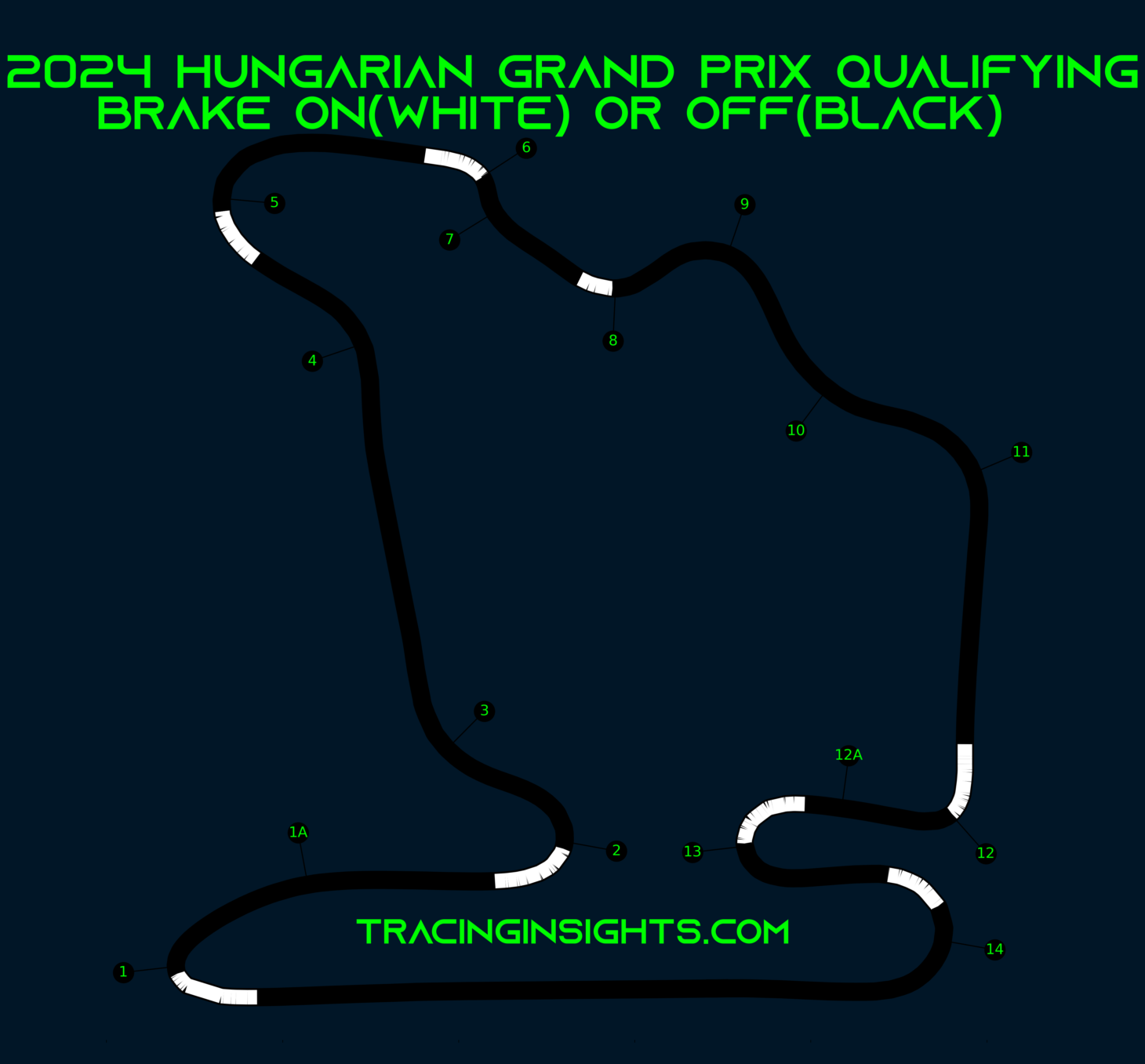
Despite these improvements, with only one true straight and a short lap, on-track passes remain less frequent than at other circuits. Strategic gains often prove more powerful than direct overtakes.
Braking Demands
The Hungaroring is exceptionally taxing on brake systems. With six significant braking events across the lap, coupled with high ambient temperatures and a lack of long straights for cooling, the components face considerable thermal load. The low average speed further restricts airflow, making brake cooling a challenge. Teams often bring circuit-specific brake ducts to aid with this.
F1 BREMBO BRAKING DATA – HUNGARIAN GP 2025
| Turn | Initial Speed (km/h) | Final Speed (km/h) | Stopping Distance (m) | Braking Time (sec) | Max Deceleration (g) | Max Pedal Load (kg) | Braking Power (kW) |
|---|---|---|---|---|---|---|---|
| ≡ 01 | 307 | 95 | 122 | 2.65 | 4.4 | 156 | 2,243 |
| = 02 | 280 | 120 | 122 | 2.59 | 4.2 | 144 | 1,989 |
| = 05 | 266 | 173 | 70 | 1.21 | 3.3 | 99 | 1,267 |
| = 06 | 252 | 119 | 76 | 1.69 | 4.2 | 150 | 1,793 |
| _ 08 | 217 | 192 | 21 | 0.37 | 2.5 | 61 | 661 |
| = 09 | 212 | 164 | 44 | 0.87 | 2.8 | 91 | 900 |
| ≡ 12 | 281 | 131 | 89 | 1.72 | 4.4 | 155 | 2,137 |
| 12a | 134 | 119 | 17 | 0.50 | 0.9 | 19 | 78 |
| = 13 | 217 | 105 | 80 | 1.92 | 3.4 | 117 | 1,239 |
| = 14 | 215 | 148 | 64 | 1.30 | 2.5 | 65 | 716 |
While not among the most demanding circuits for absolute braking force, managing friction material temperature is crucial for consistent performance and controlled wear throughout the race. Turns 1, 12, and 2 are considered the most demanding for the braking system.
Tyre Selection and Strategy
The Hungaroring's abundance of slower corners demands strong traction, which places considerable strain on the rear tires. While the track surface itself does not impose extreme wear, the circuit's twisting configuration means tires receive constant lateral loading, offering no opportunity for relief. Pirelli typically brings its C3 (Hard), C4 (Medium), and C5 (Soft) slick compounds, the same selection as the previous year. While a softer C6 compound has been introduced to Pirelli's range this season, it is considered too extreme for the Hungaroring's energy density. Although the actual loads on the tyres are not high in absolute terms, the short lap length means energy density increases cumulatively and significantly with each pass.
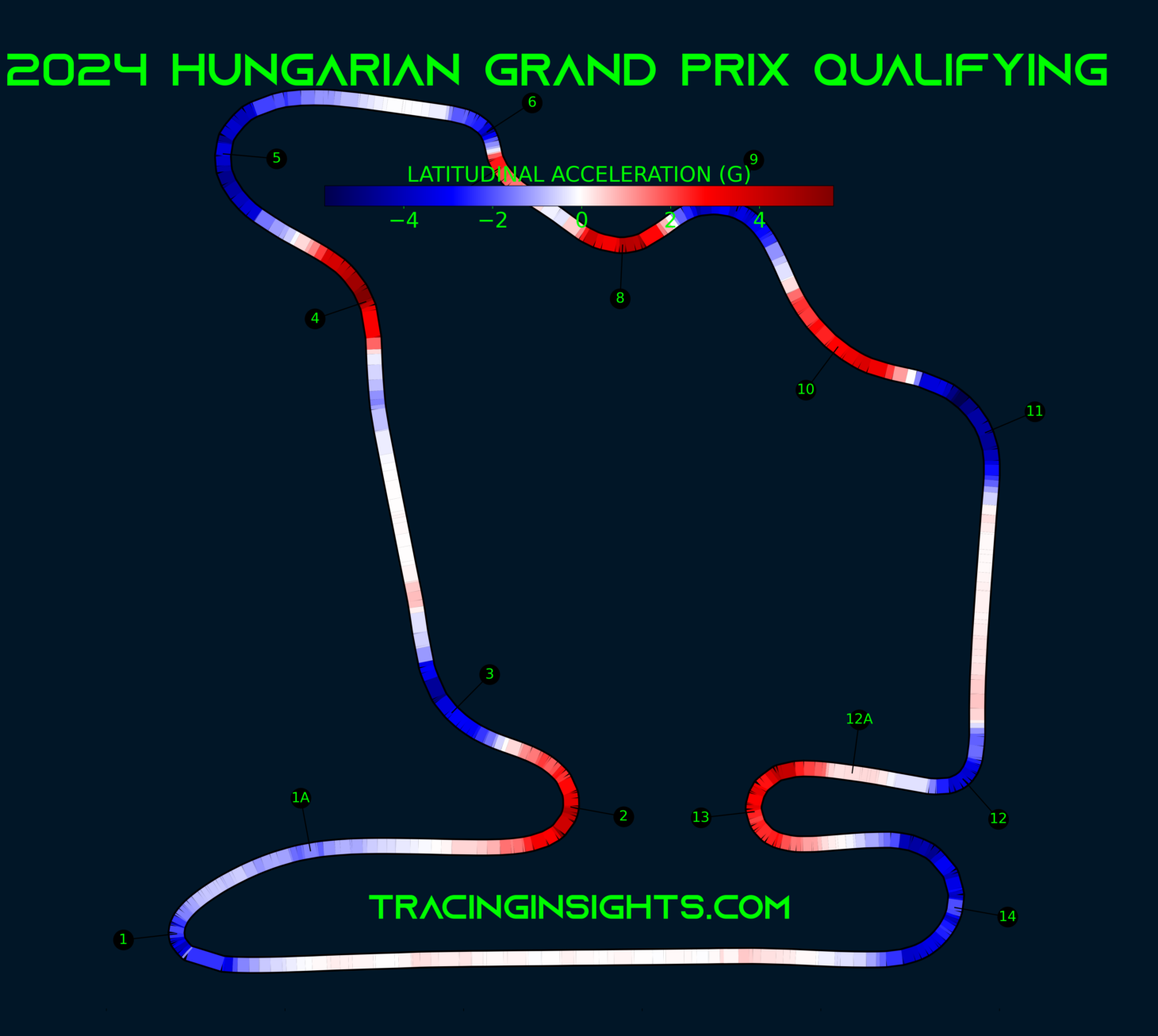
High temperatures, a common feature of the Hungarian weekend, lead to predominantly thermal degradation, a situation worsened by the very dark track surface. The 2024 race, for instance, recorded the season's highest track temperature at 58.6 °C. This makes tyre management of high importance. Graining can appear during Friday practice before gradually decreasing as the track rubbers in. High thermal degradation is a factor drivers must contend with even during a qualifying flying lap on the Soft compound; if not managed properly, it can create problems in the final two corners.
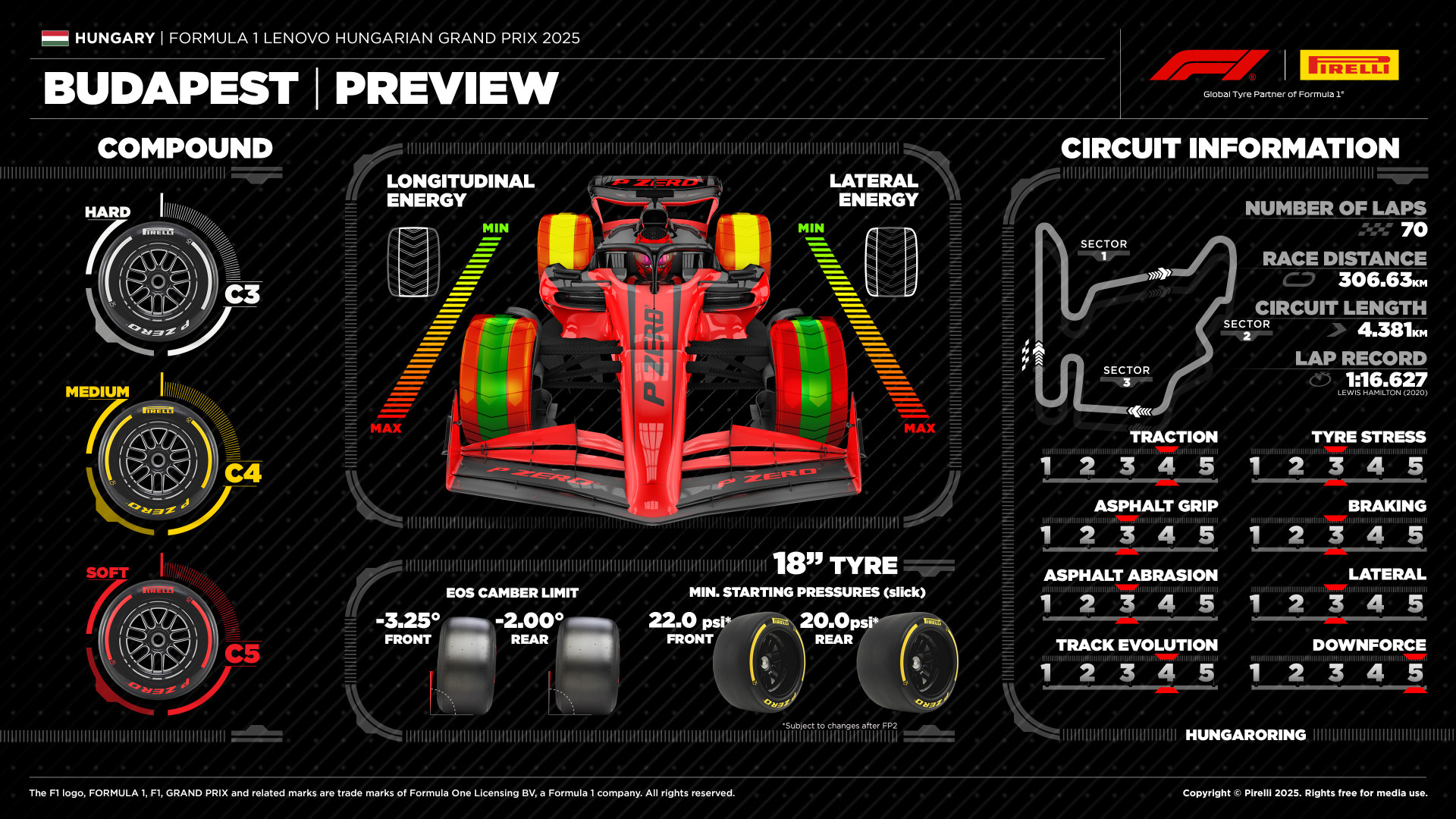
Last Year's Strategic Picture (2024 Race)
The 2024 Hungarian Grand Prix was a dry race with no Safety Car interruptions. A two-stop strategy was the most popular choice among the top finishers, primarily using combinations of the C3 and C4 compounds. The Medium compound performed well, with 13 drivers choosing it for the start. Of the remaining seven, four started on the Soft and three on the Hard.
Medium-Hard-Medium was the most popular sequence among the top six, with Lewis Hamilton in third place opting for Medium-Hard-Hard. The pit window was wide, with the first round of stops running from lap 16 to lap 23, and the second taking place between laps 40 and 49 of the 70-lap race.
Oscar Piastri won the race with a two-stop strategy, starting on new medium tyres, then switching to used hards on lap 18, and used mediums on lap 47. All of the top 10 finishers completed two stops, with the C3 and C4 compounds being the most used. Tenth-placed Lance Stroll was the only points-scorer to use the C5 Soft, starting on that tyre before moving to C4 and C2 sets.
Sergio Pérez and George Russell, starting further down the field, used a Hard tyre to run long and gain positions. Pérez finished seventh with a Hard-Medium-Medium strategy, while Russell finished eighth with Hard-Medium-Hard. Yuki Tsunoda was the only points-scorer to complete a one-stop race, finishing ninth with a Medium-Hard strategy, making his stop on lap 29. Lance Stroll completed the longest stint on the Soft, at 14 laps. No other driver ran more than seven laps on a Soft tyre.
For the upcoming race, with the same compound range but potentially more resilient tyres, a one-stop race could see more takers, though it might not be the most popular choice. Aggressive undercut windows could open from around Lap 15 if the C4 Medium compound shows signs of fading, with backup options always present.
Weather Outlook and Its Impact
As a mid-summer event in Central Europe, the Hungarian Grand Prix traditionally experiences high temperatures. The forecast for the upcoming weekend suggests sunshine and temperatures in the high 20s Celsius from Thursday through Saturday. However, there is a strong chance of showers on Sunday, which could introduce an element of unpredictability. It is worth noting that over the past 10 editions of this event, only one race (2016) has been a wet/dry affair. High temperatures contribute to the significant thermal degradation of tyres.
Historical Records and Statistics
The Hungarian Grand Prix first appeared on the World Championship calendar in 1986. Since then, it has been a permanent fixture, even during the 2020 season affected by the global pandemic. On the current calendar, only Monza boasts a longer streak of consecutive races. The F1 race in 1986 was a revival, as the first Hungarian Grand Prix was held in 1936, won by Tazio Nuvolari for Alfa Romeo.
The event has been the scene of several drivers' first Formula 1 victories. This list includes Damon Hill (1993), Jenson Button (2006), Heikki Kovalainen (2008), Esteban Ocon (2021), and Oscar Piastri (2024), along with Fernando Alonso (2003).
2025 Hungarian Grand Prix – Stat Sheet
TRACK CHARACTERISTICS
TRACTION
4/5
TYRE STRESS
3/5
ASPHALT GRIP
3/5
BRAKING
3/5
ASPHALT ABRASION
3/5
LATERAL
3/5
TRACK EVOLUTION
4/5
DOWNFORCE
5/5
Circuit Characteristics
| Characteristic | Value |
|---|---|
| Circuit Length | 4.381 km |
| Race Laps | 70 |
| Race Distance | 306 km |
| Number of Corners | 14 (6 L / 8 R) |
| Distance from Pole to First Braking Zone | 472 m |
| Pole Position Side | Left |
| Pit Lane Length Under Speed Limit Control | 365 m |
| Drive-Through Time at 80 km/h | 16s |
| Lap Time At Full Throttle | 53% |
| Lap Distance At Full Throttle | 61% |
| Gear Changes Per Lap | 57 |
| Braking Events (>2G) | 6 |
| Heavy Braking Events (<0.4s @ >4G) | 1 |
| Braking Energy | High |
| Maximum Lateral G-Force | 4.6 (T11) |
| Maximum Speed | 315.9 km/h |
| Fuel Consumption | Medium |
| DRS Zones | T14–1, T1–2 |
| Key Overtaking Opportunities | T1, T2 |
2024 Statistics
| Statistic | Value |
|---|---|
| Fastest Lap FP1 | 1:18.713 |
| Fastest Lap FP2 | 1:17.788 |
| Fastest Lap FP3 | 1:16.098 |
| Fastest Lap Q1 | 1:17.050 |
| Fastest Lap Q2 | 1:15.540 |
| Fastest Lap Q3 | 1:15.227 |
| Delta FP1 to Q3 | -3.486s |
| Delta Q1 to Q3 | -1.823s |
| Podium | PIA / NOR / HAM |
| Team Result | P3 HAM / P8 RUS |
| Fastest Race Lap | 1:20.305 (RUS) |
| Winning Race Time | 1:38:01.989 |
| Winning Average Speed | 187.669 km/h |
| Qualifying Speed Trap | 315.5 km/h (MAG) |
| Race Speed Trap | 316.2 km/h (RUS) |
| Winning Strategy | 2 Stops (L18 / L47) |
| Total Pit Stops | 40 |
| Total Normal Overtakes | 4 |
| Total DRS Overtakes | 29 |
| Race Lap Record | 1:16.627 (HAM, 2020) |
| Absolute Lap Record | 1:13.447 (HAM, Q3, 2020) |
| Not Classified (Accident/DSQ) | 0 |
| Not Classified (Mechanical) | 1 |
Race Characteristics (2020–2024)
| Characteristic | Value |
|---|---|
| Races Featuring Safety Car | 1/5 |
| Total Safety Car Deployments | 1 |
| Safety Car Probability | 20% |
| Safety Car Ratio | 0.2 |
| Wet Sessions | 8/25 |
| Wet Session Probability | 32% |
| Average Track Temperature | 35.3°C |
| Maximum Track Temperature | 47.2°C |
| Average Ambient Temperature | 23.8°C |
| Maximum Ambient Temperature | 28.5°C |
| Ambient Pressure | 982.3 hPa |
Driver Records:
-
Lewis Hamilton is the most successful driver at the Hungaroring, with eight wins, nine pole positions, and 12 podium finishes.
-
Michael Schumacher ranks second in wins (four) and pole positions (seven).
-
Kimi Räikkönen is second to Hamilton in podium finishes, with nine.
-
Two world champions have been crowned in Hungary: Nigel Mansell in 1992 and Michael Schumacher in 2001.
-
Notable historical moments include Nelson Piquet's impressive slide past Ayrton Senna at Turn 1, and Nigel Mansell's overtake on Senna in 1989 after the Brazilian hesitated with a backmarker near Turn 3.
-
The restarted 2021 Hungarian Grand Prix, following a first-lap red flag, featured the unusual sight of only leader Lewis Hamilton on the grid when the lights went out, as all other cars pitted for slick tyres.
Team Records:
-
McLaren holds the best record here with 12 wins, followed by Williams and Ferrari, both with seven.
-
McLaren and Mercedes share the lead in pole positions with nine each, with Ferrari third on eight.
-
Ferrari tops the table for podium places with 29, ahead of McLaren (25) and Williams (18).
Vital Statistics:
-
First Grand Prix: 1986
-
Track Length: 4.381 km
-
Lap record: 1m 16.627s, Lewis Hamilton, Mercedes, 2020
-
Most pole positions: Lewis Hamilton (9)
-
Most wins: Lewis Hamilton (8)
-
Pole run to Turn 1 braking point: 476 meters
-
Overtakes completed in 2024: 65
-
Safety Car probability: 25% (based on the last eight races)
-
Virtual Safety Car probability: 25% (based on the last eight races)
Follow me on Whatsapp, Telegram, Facebook, YouTube, LinkedIn, Pixelfed, Tumblr, Bsky, Twitter, Mastodon, Instagram, Sub-Reddit, Threads for more analysis!